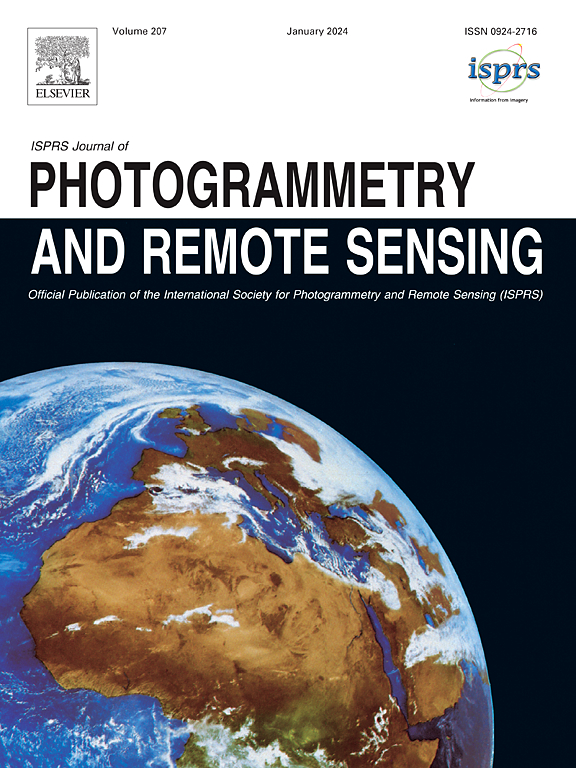使用摄影测量方法进行视觉引导机器人校准
IF 10.6
1区 地球科学
Q1 GEOGRAPHY, PHYSICAL
ISPRS Journal of Photogrammetry and Remote Sensing
Pub Date : 2024-10-04
DOI:10.1016/j.isprsjprs.2024.09.037
引用次数: 0
摘要
我们针对由摄像头或三维传感器引导的工业机器人提出了基于摄影测量的新型机器人校准方法。与最先进的方法相比,我们的方法能够同时校准机器人运动学、手眼变换,对于摄像头引导的机器人,还能同时校准摄像头的内部方位。我们的方法使用了机器人运动学和手眼变换的最小参数化。此外,它使用的相机模型能够处理机器视觉应用中通常使用的相机中可能出现的大量复杂镜头变形。为了确定模型参数,使用了具有几何意义的摄影测量误差测量方法。它们与模型的参数化无关,通常能获得更高的精度。我们对所有参数(观测值和未知数)采用随机模型,这样就能评估校准模型参数的精度和重要性。为了评估我们的方法,我们提出了与实际应用相关的新程序,这些程序不需要地面真实值。合成数据和真实数据的实验表明,我们的方法显著提高了工业机器人的绝对定位精度。通过将我们的方法应用于两个不同的未校准 UR3e 机器人(一个由摄像头引导,一个由 3D 传感器引导),我们能够将每个机器人的均方根评估误差降低约 85%。本文章由计算机程序翻译,如有差异,请以英文原文为准。
Vision-guided robot calibration using photogrammetric methods
We propose novel photogrammetry-based robot calibration methods for industrial robots that are guided by cameras or 3D sensors. Compared to state-of-the-art methods, our methods are capable of calibrating the robot kinematics, the hand–eye transformations, and, for camera-guided robots, the interior orientation of the camera simultaneously. Our approach uses a minimal parameterization of the robot kinematics and hand–eye transformations. Furthermore, it uses a camera model that is capable of handling a large range of complex lens distortions that can occur in cameras that are typically used in machine vision applications. To determine the model parameters, geometrically meaningful photogrammetric error measures are used. They are independent of the parameterization of the model and typically result in a higher accuracy. We apply a stochastic model for all parameters (observations and unknowns), which allows us to assess the precision and significance of the calibrated model parameters. To evaluate our methods, we propose novel procedures that are relevant in real-world applications and do not require ground truth values. Experiments on synthetic and real data show that our approach improves the absolute positioning accuracy of industrial robots significantly. By applying our approach to two different uncalibrated UR3e robots, one guided by a camera and one by a 3D sensor, we were able to reduce the RMS evaluation error by approximately 85% for each robot.
求助全文
通过发布文献求助,成功后即可免费获取论文全文。
去求助
来源期刊

ISPRS Journal of Photogrammetry and Remote Sensing
工程技术-成像科学与照相技术
CiteScore
21.00
自引率
6.30%
发文量
273
审稿时长
40 days
期刊介绍:
The ISPRS Journal of Photogrammetry and Remote Sensing (P&RS) serves as the official journal of the International Society for Photogrammetry and Remote Sensing (ISPRS). It acts as a platform for scientists and professionals worldwide who are involved in various disciplines that utilize photogrammetry, remote sensing, spatial information systems, computer vision, and related fields. The journal aims to facilitate communication and dissemination of advancements in these disciplines, while also acting as a comprehensive source of reference and archive.
P&RS endeavors to publish high-quality, peer-reviewed research papers that are preferably original and have not been published before. These papers can cover scientific/research, technological development, or application/practical aspects. Additionally, the journal welcomes papers that are based on presentations from ISPRS meetings, as long as they are considered significant contributions to the aforementioned fields.
In particular, P&RS encourages the submission of papers that are of broad scientific interest, showcase innovative applications (especially in emerging fields), have an interdisciplinary focus, discuss topics that have received limited attention in P&RS or related journals, or explore new directions in scientific or professional realms. It is preferred that theoretical papers include practical applications, while papers focusing on systems and applications should include a theoretical background.
 求助内容:
求助内容: 应助结果提醒方式:
应助结果提醒方式:


